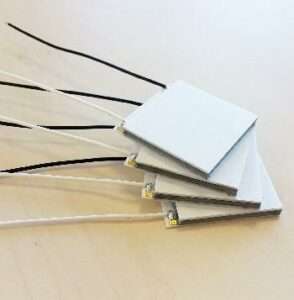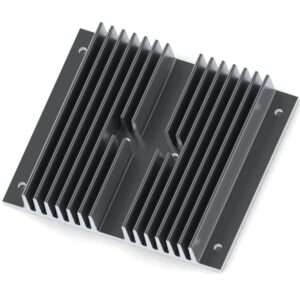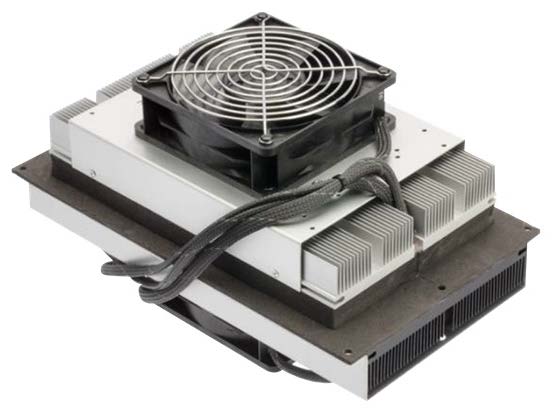Thermoelectric cooling allows for precise temperature control of sensitive industrial systems. This technology, which leverages the Peltier effect, offers unique benefits: no moving parts, no refrigerant fluids, and highly accurate thermal control. In this article, we will cover everything you need to know about thermoelectric cooling, including its strengths, limitations, and existing techniques.
What is Thermoelectric Cooling?
Thermoelectric cooling enables precise temperature control of devices without the mechanical parts or refrigerant fluids found in traditional cooling systems.
This technique uses electricity to cool elements through a phenomenon known as the Peltier effect. When an electric current flows through certain materials, it causes a heat transfer, resulting in one side of the device becoming colder while the other side heats up. In simpler terms, electricity moves heat from one location to another, creating a temperature difference between the two sides of the device.
Advantages and Disadvantages of Thermoelectric Cooling
Advantages of Thermoelectric Cooling
- No Moving Parts: Unlike traditional cooling systems, thermoelectric cooling systems do not have compressors or fans. The absence of moving parts makes the system silent and reduces the risks of mechanical wear and tear, requiring minimal maintenance.
- Precise Control: Thermoelectric cooling allows for temperature regulation by simply adjusting the electric current’s intensity, making it ideal for electronic components.
- Compact and Lightweight: Thermoelectric devices are often small and lightweight, making them perfect for tight spaces or portable elements.
Disadvantages of Thermoelectric Cooling
Despite its advantages, thermoelectric cooling has some limitations:
- Limited Efficiency: The effectiveness can be inferior to traditional cooling systems. Thermoelectric devices are effective for applications requiring light to moderate cooling but struggle with high thermal loads.
- Heat Dissipation Needs: Since one side of the device heats up while the other cools down, it is often necessary to dissipate this heat to prevent temperature buildup.
Existing Techniques in Thermoelectric Cooling
Peltier Effect Modules
Peltier effect modules are key components in thermoelectric cooling systems. They act as electronic “heat pumps,” transferring heat from one side of the module to the other when powered by electrical current.
Construction:
These modules consist of semiconductor materials sandwiched between two ceramic plates. When direct current is applied, a temperature difference is created:
- One side becomes cold and can absorb heat from its environment or the component it is cooling.
- The other side warms up by accumulating heat from the cold side, which needs to be dissipated to maintain efficiency.
When powered, Peltier modules transfer heat rapidly, offering precise temperature control. When unpowered, they function as thermal sensors, generating a low electrical current based on the temperature difference across their faces.
Compelma offers a wide range of Peltier modules that allow for quick temperature adjustments, ideal for laboratory equipment, electronics, or medical devices. These modules can be ordered directly from a standard catalog, and certain parameters (dimensions, thermal power) can be customized to meet your cooling or heating requirements. For higher thermal needs, Peltier modules can be multiplied or “multiplexed,” providing enhanced cooling capacity and achieving even greater temperature differentials.

Heat Sinks
Heat sinks are metal components (often made from aluminum or copper) designed to maximize heat dissipation. They facilitate the release of accumulated heat from the hot side of Peltier modules to prevent overheating.
Compelma specializes in custom heat sinks for demanding applications, including cooling thermoelectric modules and electronic components (PCB boards, CPUs, GPUs). Options include:
- Standard profiles available in our catalog.
- Custom solutions to meet specific application requirements, where we can produce heat sinks of various sizes and shapes, with tailored machining.
We use high thermal conductivity materials like copper or aluminum for our heat sinks, chosen for their conduction capabilities and mechanical properties. To increase dissipation, we can integrate fans into the heat sink or provide thermal interfaces that enhance contact between the heat sink and the component, eliminating air pockets (a thermal insulator) and ensuring maximum thermal conductivity.

Thermoelectric Assemblies
Thermoelectric assemblies combine multiple components to provide a complete Peltier cooling solution. This all-in-one solution includes:
- A Peltier module.
- A heat sink on each side.
- Thermal interfaces.
- In some cases, a fan mounted on the heat sinks to enhance heat transfer.
Compelma provides integrated assemblies that include Peltier modules, appropriate heat sinks, and thermal interfaces. This ready-to-use solution is ideal for those looking for quick installation and optimized performance without the hassle of assembling components themselves.
We use carefully selected heat sinks and thermal interfaces to ensure effective dissipation of the heat generated by the Peltier module. Again, the assemblies can be fully customized to meet the specific power, size, and thermal dissipation requirements of each project.
Do you need components for the thermoelectric cooling of your applications? Contact the Compelma team without delay!

